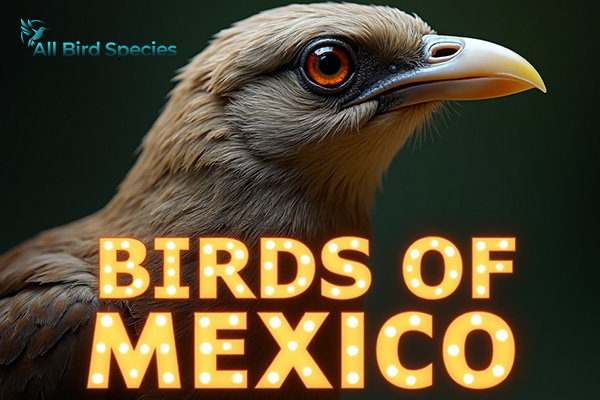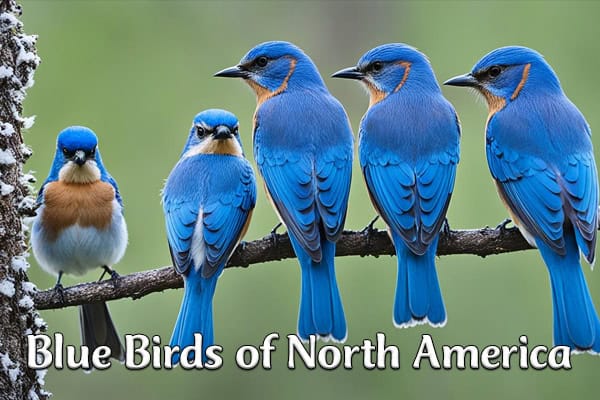Top 13 Birds Of Mexico (With Stunning Photos)
Birds In Mexico is a paradise for bird lovers, with 1,040 bird species, 125 of which are unique to the country. Its varied landscapes, from lush forests to dry deserts, support a wide range of birds. This article will highlight 13 amazing bird species found in Mexico, from the Golden Eagle to the Broad-billed Hummingbird. Get ready to learn about their unique looks, behaviors, and the stories they share about Mexican birdlife.
What mysteries do these top Mexican birds hold? How do they survive in such diverse environments? Let’s explore the world of Mexico’s birds together. We’ll discover their amazing adaptations and the stories behind them.
~Explore 13 Bird Species Found In Mexico~
1. Great-tailed Grackle
- Scientific Name: Quiscalus mexicanus
- Size: About 15-18 inches (38-46 cm) long
The Great-tailed Grackle, known scientifically as Quiscalus mexicanus, is a striking bird that stands out in the Mexican landscape. With its glossy black feathers and long tail, it exudes an air of confidence.
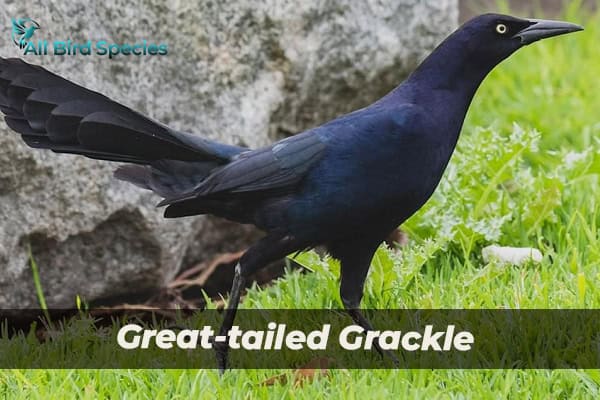
These birds are often seen foraging in urban areas, parks, and agricultural fields. Their adaptability makes them a common sight throughout Mexico. They have a varied diet that includes insects, fruits, and even scraps from human activities.
Their vocalizations are loud and diverse—ranging from harsh calls to melodious whistles. This adds a lively soundtrack to their surroundings.
Great-tailed Grackles are social creatures, frequently found in large flocks. Watching them interact can be quite entertaining as they engage in various behaviors like chasing each other or displaying during courtship rituals.
2. Canyon Towhee
- Scientific Name: Melozone fusca
- Size: About 8-9 inches (20-23 cm) long
The Canyon Towhee is a striking bird found primarily in the arid landscapes of Mexico and parts of the southwestern United States. Its subtle yet beautiful plumage features warm browns with grayish undertones, harmonizing perfectly with its rocky habitat.
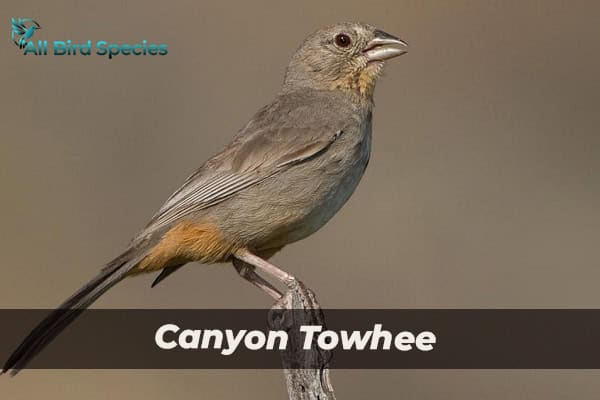
Often spotted foraging on the ground, this medium-sized bird has an unassuming presence but catches attention with its distinctive call—an unmistakable series of whistles that echo through canyons and open spaces.
Canyon Towhees are known for their habit of scratching at the ground to uncover seeds and insects hidden beneath the surface. Watching them hop around in search of food provides a delightful glimpse into their behavior.
These birds usually prefer shrubby areas, making them relatively easy to observe if you find yourself wandering through their chosen terrain. Their adaptability allows them to thrive in various environments, showcasing nature’s ingenuity.
3. Great Kiskadee
- Scientific Name: Pitangus sulphuratus
- Size: About 8.7-10.2 inches (22-26 cm) long
- Lifespan: 6-7 years in the wild
Birds In Mexico are a haven for many bird species, and the great kiskadee stands out. This bird has bright yellow underparts, a black-and-white striped head, and rufous wings and tail. It’s a highlight among Mexico’s colorful birds.

The great kiskadee thrives in many places in Mexico, like woodlands, savannas, and even cities. They love to be near water, where they catch insects, small frogs, lizards, and more. Their sharp beaks help them eat a wide variety of food.
There are three subspecies in Mexico, spread from the southeast to the Pacific coast and central Mexico. They live up to 1,800 meters high, making them easy to spot for bird lovers.
The great kiskadee is loved for its bright colors and how well it adapts to different places. Its common presence and stable numbers add to Mexico’s rich bird life. It’s a favorite among those who enjoy watching birds.
4. Magnificent Frigatebird
- Scientific Name: Fregata magnificens
- Wingspan: 7.5-8.5 feet (2.3-2.6 meters)
- Lifespan: Can live up to 10-15 years in the wild
The Magnificent Frigatebird, known as Fregata magnificens, is a stunning seabird found on Mexico’s coasts. It has an impressive wingspan of up to 7-½ feet (2.3m). This large bird is known for its flying skills and unique look.
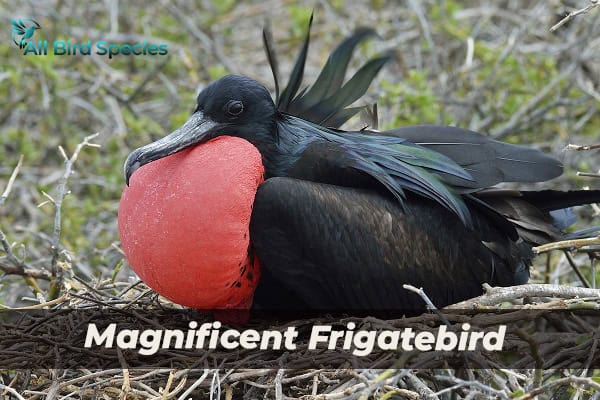
The male has shiny black feathers, a forked tail, and a long, hooked beak. In the breeding season, he shows off a bright red throat pouch to attract mates. The female looks different, with a white chest, a pale brown wing bar, and a gray throat pouch.
These seabirds live along Mexico Pacific and Atlantic coasts, in the southern U.S., and in the Caribbean. They like tropical and subtropical places, nesting on cliffs, mangroves, and man-made structures. They are great fishermen, eating fish, squid, crustaceans, and small turtles from the water.
Despite being big, Magnificent Frigatebirds are the lightest birds in relation to their wings. This lets them fly easily, spending most of their time in the air. They rarely land on water because they don’t have waterproof feathers. They can go far inland during storms, flying away from the sea.
5. Black Vulture
- Scientific Name: Coragyps atratus
- Wingspan: 4.5-5.5 feet (1.4-1.7 meters)
- Body Length: About 24-28 inches (61-71 cm)
- Lifespan: Can live up to 10-15 years in the wild
The black vulture birds of Mexico, or Coragyps atratus, is a large bird of prey with all-black feathers and a bald, grayish-black head. They are common in Mexico, where they are important scavengers in different ecosystems.

These vultures live in many places, from forests and grasslands to cities. They use their great eyesight to find food, mainly carrion. They eat a lot of different things, like big animals, small scraps, insects, fish, reptiles, and plants.
The black vulture is the only living bird in its group, Coragyps. It can be found from the southeastern U.S. to Peru, Central Chile, and Uruguay. In Mexico, there are many more of these vultures in the south and center than in other U.S. states.
Black vultures are very opportunistic and sometimes aggressive when looking for food. They often take food away from turkey vultures. Sometimes, they even attack and kill animals, but this is not common. Still, they are very important in Mexico’s ecosystems, especially in places like the Sierra Gorda Biosphere Reserve in Querétaro.
6. Mexican Jay
- Scientific Name: Cyanocitta mexicana
- Body Length: About 10-12 inches (25-30 cm)
- Wingspan: Around 15-18 inches (38-46 cm)
- Lifespan: Can live up to 7-10 years in the wild
The Mexican jay (Aphelocoma wollweberi) is a beautiful blue songbird in Mexico. It has blue feathers on top, a gray back patch, and a grayish belly. This jay is a joy to see in pine-oak forests and woodlands. It lives in close family groups of up to 25 birds.
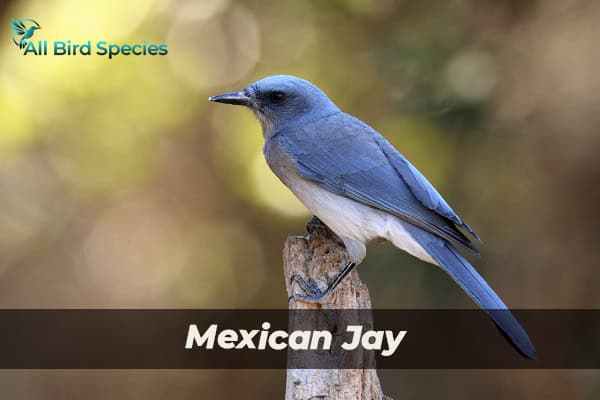
These birds in Mexico are very social and have many nests together. They collect about 7,000 acorns a year. The young jays have white on their bills that takes over two years to turn dark.
Mexican jays are great at finding food. They eat nuts, berries, insects, and even small animals. They live in different places, from forests to deserts with streams.
The Mexican jay is not considered endangered, but it was split into two species recently. This was because of genetic and physical differences. Learning about these birds helps us appreciate Mexico’s bird diversity.
7. Great Egret
- Scientific Name: Ardea alba
- Body Length: About 36-41 inches (91-104 cm)
- Wingspan: Around 52-67 inches (132-170 cm)
- Lifespan: Can live up to 15-20 years in the wild
The great egret, also known as the Ardea alba, is a stunning sight in Mexico’s wetlands. It has a tall, majestic look with white feathers, a long neck, and a sharp yellow bill. You can find it in places like freshwater marshes, estuaries, and flooded fields.

When it’s breeding season, the great egret changes a lot. It grows long feathers on its back and neck, and its face turns green. Its bill also turns black. This change is for mating and living with other birds like herons and ibises.
This bird lives on every continent except Antarctica. In Mexico, there’s a special kind called the Ardea alba egretta. Some of these birds stay in Mexico all year, while others move south for winter.
Great egrets are great hunters. They wait in shallow water for fish, frogs, small mammals, and more. Their wide diet and ability to live in different wetlands help them thrive. This makes them an important part of Mexico’s bird life.
8. Golden Eagle
The golden eagle (Aquila chrysaetos) is a majestic birds of prey in Mexico. It has dark brown feathers, a golden-brown neck, and a big blue-gray beak. This bird is one of the biggest in Mexico, known for its size, strength, and hunting skills.

These birds of Mexico live in mountains and open areas with little vegetation. They hunt small to medium mammals, birds, seals, fish, or carrion. Found in North America, Europe, Asia, and northern Africa, the golden eagle is Mexico’s national bird.
Golden eagle numbers in Mexico are going down, mainly because of less good living space. Conservationists are trying to save this species and its home. The golden eagle is seen as “in danger” in Mexico’s Federal Hunting Law. By learning about their lives and homes, we can help protect the golden eagle for the future.
9. Broad-billed Hummingbird
The Broad-billed Hummingbird (Cynanthus latirostris) is a standout among Mexico’s colorful birds. It’s small but has vibrant colors and amazing flying skills. Birdwatchers and nature lovers find it a joy to see.

The male Broad-billed Hummingbird is eye-catching. It has bright green feathers on top and bottom, a blue throat, and a long, straight red bill. Females are less flashy, with pale green back, grayish belly, white eye stripe, and a white throat.
These birds live in canyons, riparian woodlands, and thorn forests in Mexico and a bit of the southwestern U.S. They eat nectar from flowers. Their long tongues help them drink nectar while hovering in front of flowers.
Each day, a male Broad-billed Hummingbird eats about 1.6 to 1.7 times its body weight in nectar. This shows how much energy they need. They also defend their food spots fiercely, chasing off other males and big insects.
The Broad-billed Hummingbird is a treasure among Mexico’s birds. It enchants everyone who sees its bright colors and flying skills.
10. Golden-fronted Woodpecker (Melanerpes aurifrons)
The Golden-fronted Woodpecker is a striking bird that captivates anyone lucky enough to spot it. With its vibrant yellow crown and bold black-and-white plumage, this woodpecker stands out against the lush landscapes of Mexico.
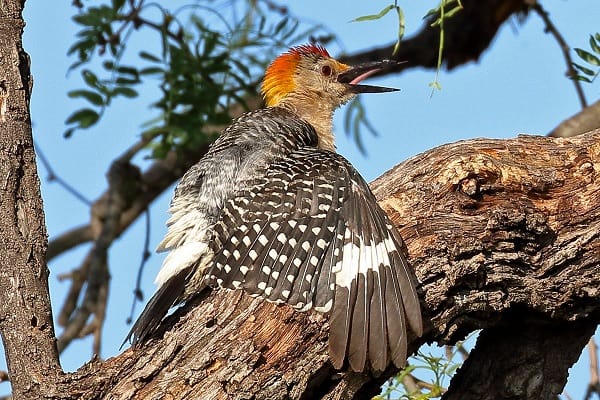
You’ll often find them in open woodlands or urban areas, where they skillfully cling to tree trunks. Their distinctive drumming resonates through the air as they search for insects hidden beneath bark.
These birds are not just visually stunning; they also play a vital role in their ecosystems. By creating cavities in trees, they provide nesting sites for other wildlife.
Their call—a series of sharp notes—is another characteristic that makes them easily recognizable. Observing these dynamic creatures brings joy to birdwatchers and nature enthusiasts alike. Whether perched high on a branch or energetically tapping away at a tree, the Golden-fronted Woodpecker is truly an emblem of avian beauty in Mexico’s diverse habitats.
11. Bewick’s Wren (Thryomanes bewickii)
The Bewick’s Wren is a small, energetic bird that captures attention with its charming personality. With a distinctive long tail and subtle brown plumage, it blends beautifully into its surroundings.
Often found in shrubby areas or near water sources, this wren is known for its curious nature. It flits around low vegetation, searching for insects and spiders to snack on. The Bewick’s Wren possesses an impressive vocal range; their melodic songs are often described as cheerful and complex.
These birds are quite social, frequently seen in pairs or small groups. Their lively antics can be entertaining to watch as they hop energetically from branch to branch.
With a wide distribution across Mexico and parts of the United States, spotting one can be a delightful surprise during any birdwatching adventure! Keep your eyes peeled for this feisty little creature while exploring the diverse avian life in Mexico.
12. Vermilion Flycatcher (Pyrocephalus rubinus)
The Vermilion Flycatcher Birds In Mexico is a striking bird that captures attention with its vivid red plumage. Males are particularly eye-catching, boasting bright crimson feathers on their underparts, contrasting beautifully with dark wings and tails.
These birds prefer open habitats like savannas and grasslands, often seen perched on low branches or fences. Their agile flight allows them to dart after insects mid-air, showcasing impressive aerial skills.
Female Vermilion Flycatchers exhibit more subtle earth tones but retain a charm of their own. They play an essential role in the ecosystem by helping control insect populations.
During breeding season, males engage in captivating displays to attract females. Their cheerful calls echo through warm afternoons as they stake out territory. Observing these vibrant birds can be a delightful experience for nature enthusiasts exploring Mexico’s rich avian diversity.
13. Inca Dove (Columbina inca)
The Inca Dove is a charming birds often seen in urban areas and open woodlands across Mexico. With its slender body and long tail, it captivates bird watchers and casual observers alike.
This dove showcases beautifully scaled plumage with soft grayish-brown tones. Its unique appearance is complemented by a distinctive white-tipped tail that provides an elegant contrast against its muted feathers.
Inca Doves are social creatures, frequently spotted foraging on the ground in small groups. They primarily feed on seeds, grains, and other plant materials, making them a familiar sight around parks and gardens.
Their gentle cooing adds to their appeal, creating a serene atmosphere wherever they gather. Observing these doves can be an enchanting experience as they interact playfully with one another while basking in the sun or perched on low branches.
Check Our Previous Articles:
Final Thoughts:
Bird watching in Mexico offers a unique opportunity to connect with nature and appreciate the rich biodiversity of this vibrant country. Each bird species brings its own charm and character, captivating enthusiasts and casual observers alike. From the striking Great-tailed Grackle to the elegant Magnificent Frigatebird, every sighting can turn an ordinary day into an extraordinary experience.
With over 1,000 species recorded across various habitats—from deserts to rainforests—Mexico is a haven for bird lovers. Whether you’re hiking through lush mountains or exploring coastal areas, there’s always something new to discover. The beauty of these birds not only enhances our understanding of ecosystems but also emphasizes the importance of conservation efforts.
As more people engage in bird watching, awareness grows about protecting their natural habitats. This engagement fosters an appreciation for wildlife that transcends borders and cultures. For anyone interested in exploring the avian wonders of Mexico, each observation becomes part of a larger journey toward environmental stewardship.
So grab your binoculars and camera; adventure awaits among the skies filled with colorfully feathered friends!

